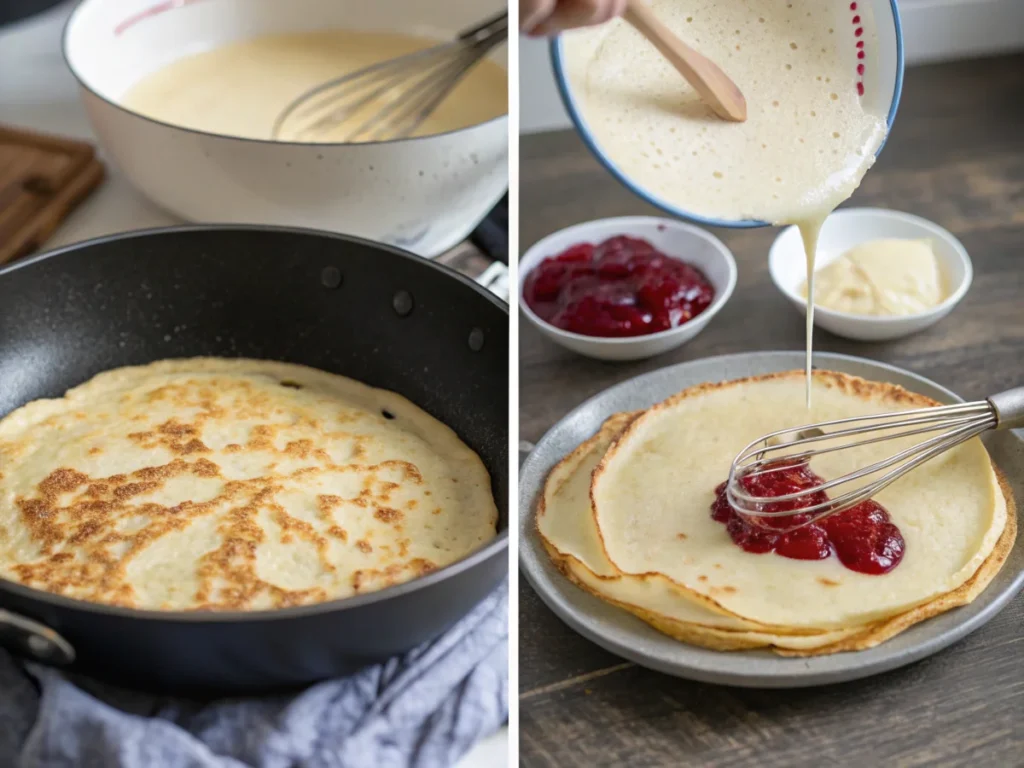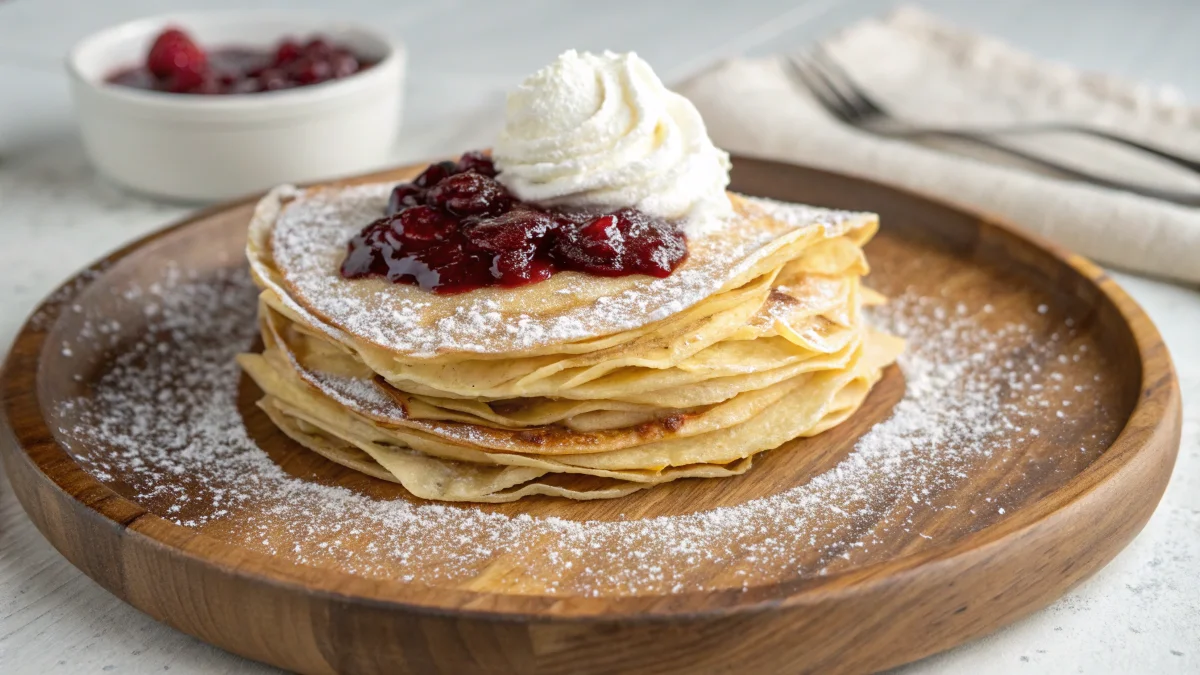You ever had a pancake so thin, buttery, and melt-in-your-mouth soft that you almost forgot what an American pancake even tastes like? If not, let me introduce you to Swedish pancakes—the delicate, lacy cousin of traditional flapjacks.
These beauties are light, slightly sweet, and ridiculously easy to make. Unlike thick, fluffy buttermilk pancakes, Swedish pancakes (or pannkakor in Sweden) are closer to crepes—except they’re softer, richer, and packed with a subtle sweetness that pairs perfectly with fruit, jam, or even savory fillings.
In this guide, we’re covering everything you need to know about these Scandinavian delights: from their history to the best toppings, plus a foolproof recipe that’ll have you flipping like a pro. Let’s get started!
Part 1: What Are Swedish Pancakes?
The Origin and History
Swedes have been making pancakes for centuries, and while no one can pinpoint exactly when they first appeared, one thing is certain—these pancakes are a staple in Swedish cuisine. Historically, they were served on Thursdays alongside ärtsoppa (a thick pea soup). But why Thursdays? Back in the day, it was a common pre-Friday fasting meal in Sweden. As a result, pancakes became the sweet reward after a hearty bowl of soup.
Nowadays, they’re not just a Thursday thing—they’re an everyday favorite. Whether it’s breakfast, dessert, or even a quick snack, Swedish pancakes always find their way onto the table.
How Swedish Pancakes Differ from American Pancakes and Crepes
Okay, so what makes Swedish pancakes different from your usual stack of buttermilk pancakes?
- They’re thinner and eggier – The batter has more eggs and milk, which makes them softer and more flexible.
- Less baking powder (or none at all) – American pancakes rely on baking powder to puff up. Swedish pancakes? They stay thin and delicate.
- More butter = more flavor – Seriously, the butter gives them a rich, slightly crispy edge that’s chef’s kiss perfect.
- No maple syrup required – Instead, they’re usually topped with lingonberry jam or powdered sugar.
And while Swedish pancakes look similar to French crepes, they’re sweeter, softer, and more buttery—so they don’t need as much filling to taste amazing.
Why Swedish Pancakes Are a Popular Breakfast and Dessert
Let’s be real—who wouldn’t want a breakfast that tastes like dessert? After all, Swedish pancakes are a fan favorite. They’re light enough for a morning treat, yet fancy enough to serve as a dessert with whipped cream and berries.
On top of that, they’re fun to make! Whether you’re flipping them like a pro or accidentally folding them into a pancake taco (which, let’s be honest, happens to the best of us), there’s something so satisfying about getting that perfect golden-brown pancake onto your plate.
Oh, and did I mention they freeze beautifully? Better yet, you can make a big batch, freeze ‘em, and pop them in the microwave for a quick breakfast. Because of this, you’ll never look at store-bought frozen pancakes the same way again.
That’s the lowdown on Swedish pancakes! Up next, we’re diving into the ingredients—because, let’s be honest, the magic is all in the batter. So, don’t go anywhere!😊
Part 2: Essential Ingredients for Authentic Swedish Pancakes
If you want Swedish pancakes that taste just like the ones from a cozy café in Stockholm, you gotta get the ingredients right. The good news? You probably already have everything in your kitchen!

Key Ingredients and Their Role in the Recipe
Making Swedish pancakes is all about balancing simple ingredients to get that soft, buttery texture. Here’s what you’ll need:
- Eggs – They give the pancakes structure and help create that flexible, crepe-like texture.
- Milk – Whole milk is best for a rich, creamy batter. Want them extra light? Try adding a splash of water.
- Flour – Regular all-purpose flour works perfectly. Keep it light—no need for the heavy stuff!
- Sugar – Just a little! Unlike American pancakes, Swedish pancakes don’t rely on sweetness in the batter. The toppings do the job.
- Butter – This is the secret to pancakes that are soft in the middle and crisp around the edges. Don’t skimp!
- Salt – A pinch enhances the flavors without making the pancakes taste salty.
Choosing the Right Type of Milk and Flour
Whole milk makes these pancakes extra rich, but you can swap in oat or almond milk if you’re dairy-free. As for flour, stick with all-purpose—whole wheat makes them too dense, and cake flour is too delicate.
Why Butter Is Crucial for Flavor and Texture
Ever had a pancake that tastes kinda… bland? That’s what happens when you don’t use enough butter. Melted butter in the batter makes Swedish pancakes tender, while butter in the pan helps create golden, lacy edges. In short: butter is non-negotiable.
Part 3: Step-by-Step Guide to Making Swedish Pancakes
Alright, let’s get to the fun part—cooking! Swedish pancakes are quick and easy, but a few tricks make all the difference.

Preparing the Batter: Tips for the Perfect Consistency
- Crack the eggs into a bowl and whisk until smooth.
- Slowly add milk while whisking.
- Sift in the flour, sugar, and salt—this helps avoid lumps!
- Mix until smooth, then stir in melted butter. The batter should be thin, almost like heavy cream.
Pro tip: Let the batter rest for 15 minutes. This helps everything settle, making the pancakes even smoother.
The Right Way to Cook : Pan, Temperature, and Technique
- Heat a nonstick pan or crepe pan over medium heat.
- Add a little butter and swirl it around.
- Pour about ¼ cup of batter into the pan, tilting it so the batter spreads into a thin layer.
- Cook until the edges start to crisp and the bottom turns golden (about 1-2 minutes).
Flipping and Folding Techniques for Perfect Pancakes
- Use a thin spatula to gently lift the edges.
- Once the bottom is golden brown, flip it! Swedish pancakes cook fast, so don’t walk away.
- Fold or roll them up and stack them on a warm plate.
And there you go—perfectly soft, buttery Swedish pancakes! Next up, we’re talking toppings (because let’s be real, that’s the best part). 😊
It looks like there are no specific recipe pages listed in the sitemap for internal linking. However, I’ll suggest that readers check out other delicious recipes on the site for more inspiration.
Part 4: Traditional and Modern Swedish Pancake Toppings
What’s a pancake without toppings? Pretty sad, honestly. The best part about Swedish pancakes is how well they pair with both sweet and savory flavors. Whether you’re a jam lover or a cheese fanatic, there’s a topping combo for you.
Classic Lingonberry Jam and Whipped Cream
If you want to keep things authentically Swedish, you have to try lingonberry jam. These tiny red berries are tart—think cranberries but milder—and balance out the sweetness of the pancakes beautifully. A dollop of fresh whipped cream on top? Perfection.
Other Popular Toppings: Sugar, Lemon, and Fresh Berries
Sometimes, simple is best. A sprinkle of powdered sugar, a squeeze of lemon juice, or a handful of fresh berries (such as strawberries, raspberries, or blueberries—take your pick) can instantly turn Swedish pancakes into a light, refreshing treat. Not only that, but these toppings also add a nice balance of sweetness and acidity.
Savory Options: Cheese, Herbs, and Smoked Salmon
Who says pancakes have to be sweet? In fact, in Sweden, it’s common to fill them with cheese, fresh herbs, or smoked salmon for a more filling meal. For example, try rolling your pancakes with cream cheese, dill, and smoked salmon—it’s next-level good and perfect for brunch. Plus, the creamy texture pairs beautifully with the delicate pancakes.
👉 For more delicious recipes, check out this collection of recipes for new ideas!
Part 5: Swedish Pancakes Around the World
You might think Swedish pancakes are unique to Sweden, but similar pancakes exist all over the world. Each country has its own take, and honestly, they’re all worth trying.
How Swedish Pancakes Compare to Other Global Variations
- French Crêpes – Slightly thinner and less buttery, crêpes are the closest cousin to Swedish pancakes.
- Dutch Pannenkoeken – Larger, thicker, and often filled with ingredients like bacon or apples.
- Russian Blini – Smaller and fluffier, sometimes made with buckwheat flour.
- Finnish Lettu – Nearly identical to Swedish pancakes but often served with fruit preserves.
Regional Swedish Pancake Recipes and Adaptations
Even within Sweden, pancakes vary. For instance, in the north, they’re often made with barley flour, giving them a heartier texture. Meanwhile, some versions, like ugnspannkaka, are baked in the oven, making them more like a pancake casserole than a traditional skillet pancake.
Modern Twists on the Traditional Recipe
These days, people are putting their own spin on Swedish pancakes—from chocolate-filled delights to protein-packed versions for a healthier take. Regardless of the variation, one thing’s for sure: they’ll always be delicious.
Up next, let’s talk nutrition and how to make these pancakes a little healthier!😊
Part 6: Nutritional Value and Health Benefits
Let’s be real—Swedish pancakes aren’t exactly a superfood. But hey, life’s all about balance! These pancakes can actually be part of a well-rounded diet if you pay attention to ingredients and portion sizes.
Calorie Count and Macronutrient Breakdown
A standard serving of Swedish pancakes (about 3 pancakes) typically contains:
- Calories: ~250-300
- Carbs: 30-40g
- Protein: 7-9g
- Fat: 10-15g
Since they’re made with eggs and milk, Swedish pancakes have more protein than regular crepes. But let’s be honest—the toppings are what really determine whether this dish leans toward indulgence or balance.
Healthier Alternatives: Using Whole Wheat Flour and Low-Fat Milk
Want to lighten things up? Try these swaps:
- Use whole wheat flour instead of all-purpose for extra fiber.
- Swap in low-fat or almond milk for fewer calories.
- Go easy on the butter—use a nonstick pan so you don’t need as much.
Gluten-Free and Dairy-Free Adaptations
Good news: Swedish pancakes can easily be made both gluten- and dairy-free! For a simple swap, try using gluten-free flour blends or oat flour instead of regular flour. Likewise, for a dairy-free version, coconut or almond milk works like a charm. Plus, adding a little extra butter substitute helps maintain that classic rich flavor.
The bottom line? You don’t have to skip out on these delicious pancakes—instead, just tweak the recipe to fit your lifestyle!
Part 7: Frequently Asked Questions (FAQ)
Got questions? You’re not alone! Here are some of the most common ones people ask about Swedish pancakes.
What is the difference between Swedish pancakes and crepes?
Both are thin, but Swedish pancakes have more eggs and butter, making them softer and richer. Crepes tend to be drier and firmer.
Can I make Swedish pancakes ahead of time?
Yes! They store well in the fridge for up to 3 days or in the freezer for up to a month. Just layer them with parchment paper so they don’t stick together.
How do I store and reheat Swedish pancakes?
- Fridge: Stack pancakes with parchment paper and store in an airtight container.
- Reheat: Pop them in the microwave for 15-20 seconds or warm them in a pan with a little butter.
What are some common mistakes when making Swedish pancakes?
- Batter too thick? Add more milk.
- Edges burning? Lower the heat.
- Pancakes ripping? Flip them gently with a thin spatula.
Are Swedish pancakes suitable for a keto or low-carb diet?
Traditional ones? Not really. But you can make low-carb versions with almond flour and heavy cream instead of milk.
And that’s a wrap! Ready to whip up a batch of Swedish pancakes? Grab your ingredients and get flipping! 😊

